Training material
Section 1 – The Mastic Cultivation Process
Processes performed by mastic growers
Cultivation of new trees: The cultivation of new trees takes place during the winter, from the beginning of January until mid-February. The producers cut branches from a male tree of good quality and plant them in depth of 40 to 60 centimetres. It is rather easy for a plant to be successful and it does not need special care in the beginning.
Pruning, cleaning, fertilization, and irrigation: Pruning of a tree begins on its third year and then takes place every year during the winter, from the beginning of January until mid-February. The dry branches are removed so that the tree can become stronger and to facilitate air and sun supply for the trees. The wounds from the cut branches are covered with a substance (katrami) to proof them from microorganisms. Fertilization of the field takes place in January or February and the producers use ammonium sulphate when the soil is poor and potassium nitrate or calcium ammonium nitrate for red soil. An ecological fertilizer is beans (Vicia faba) which are planted in October. When they reach the time to bloom they are plowed in order to stop their growth. Because of the bacteria staying in the nearly bloomed beans, the soil becomes rich in nitrogen which is essential for the growth of the mastic trees. Young trees do not need water. Irrigation starts after the first year of the tree and it takes place two, three or four times per day depending the weather conditions. The older trees are resistant to drought. It is important to note that persistent humidity can damage the trees to the point of drying and become sensitive in infections.
Cleaning the soil: At the end of June until the beginning of July, producers clean, level and press the soil under the trees. Then the soil is covered with white clay so that the mastic resin that will fall will stay clean.
Kendima (embroidering): Kendima (as it is called in Greek; embroidering) takes place in July and August. The producers create vertical or linear incisions on the bark of the tree. The incisions are 4 to 5 centimetres deep and 10 to 15 centimetres long. The number of the incisions depend on the size of the tree. Vertical wounds heal faster. After kendima, the resin is left 10 to 20 days to dry.
Collecting: Collection of the dried mastic resin takes place from mid-August till mid-October. Usually big mastic pieces of resin fall on the soil while mastic ‘tears’ remain and dry on the bark and the branches.
Sifting and cleaning: Sifting helps to separate mastic gum from gathered dirt and leaves.
Cleaning with water: After sifting the producers clean the gum with soap and plenty of water. Producers that live in a village near the sea prefer to go to the seaside to clean the gum. It is easier in that way to separate them because the salty water keeps the dirt and leaves on the surface of the water while the mastic gum stays at the bottom of the basin.
Tsimbima (pinching): Tsimbima (as it is called in Greek; pinching) is the cleaning of the mastic gum with special knives in order any last dirt attached to the gum. It is performed by women.
Classification: Producers make a first classification of the mastic gum that is collected according to the following types:
- Pitta: flattened round pieces of 3-7 cm, they are created when many mastic drops fall on top of one another
- Fliskari or kandilera: smaller than pitta, more translucent, they hang from the incision
- Dachtilopetra: smaller than fliskari, they name means “rock of a finger ring”
- Tear: smaller than dachtilopetra, it takes its name because it is hanging from the tree like a “tear”
- Kiliasto or psilo: very small pieces in round shape that dry fast, they fall and roll on the ground
- Anapinada or neropinada: of lower quality because while drying it has absorbed water or dirt and therefore its economic value is lost
- Volarida or apovoliariki: mastic gum has gathered together and became a lump. That happens when the mastic is gathered before getting dry. Its economic value is diminished
- Dust: residues of processing
After the classification, mastic gum is sent to the Chios Mastic Growers Association in November.
Processes performed by the Chios Gum Mastic Growers Association
General processing upon arrival of mastic: When the Association receives mastic gum from the producers, further classification takes place according to the size of the gum. In general, they separate the pittas (usually large, round pieces), chondri (‘fat’ pieces) and psili (thin pieces). In this way they store the gum and gradually process it further depending on the demand. Sifting, cleaning with water, drying, weighting, tsimbima (pinching) take place.
Chewing gum production: For the production of mastic chewing gum, first the mixture is prepared which is made out of mastic, sugar, butter, corn flour, and water. The ingredients are placed in the blending machine to produce the mixture. After 15 minutes the mixture is taken out of the blending machine and it is placed on a marble counter. Then it is formed to pieces of maximum height 3 centimetres and left to cool. After cooling the pieces are transferred to the press and engraving machine where they are press and gum dragees are formed. At the end the dragees are cut and put in the candy machine to create their coating made out of syrup.
Mastic oil production: Mastic oil is produced through distillation.
Mastic Cultivation Tools
| Amia* Image from PIOP archive | Old agricultural tool with metal head and wooden handle used for the preparation of the soil before kendima (embroidering) | 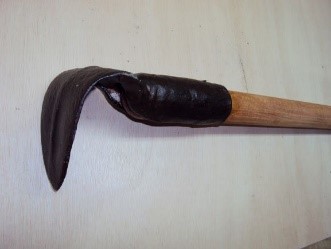 |
| Axe Image from PIOP archive | Agricultural tool with metal head and wooden handle |  |
| Kenditiri* Image from PIOP archive | Metal agricultural tool with metal or wooden handle to make incisions on the mastic tree | 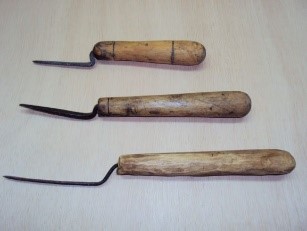 |
| Baltadaki* Image from PIOP archive | A variation of kenditiri | 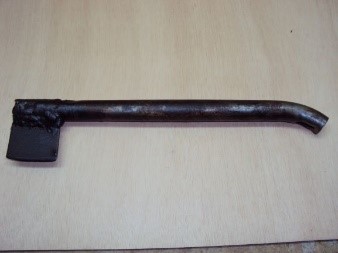 |
| Korakomiti Image from PIOP archive | A variation of kenditiri | 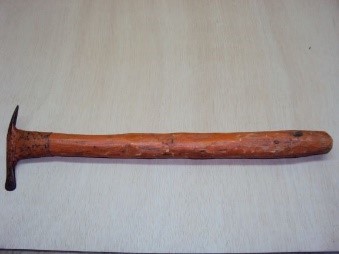 |
| Pickax Image from PIOP archive | Agricultural tool with metal head and wooden handle | 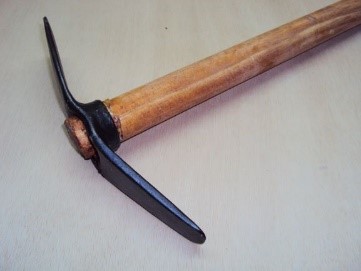 |
| Pruning hook Image from PIOP archive | Agricultural tool for pruning with wooden handle and metal hooked blade | 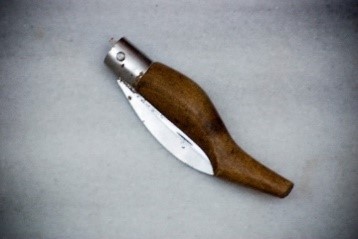 |
| Rake Image from PIOP archive | Agricultural tool with metal head and wooden handle |  |
| Saw Image from PIOP archive | Agricultural tool with metal head and wooden handle used to cut the branches of the tree |  |
| Shovel Image from PIOP archive | Agricultural tool with metal head and wooden handle used to clean and prepare the ground around the tree before kendima (embroidering) |  |
| Sieve Image from PIOP archive | Round shaped tool of variable sizes with wooden wall and metal mesh used to sieve the mastic gum | 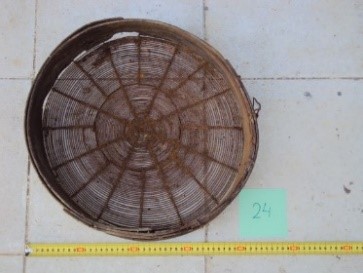 |
| Dramoni Image from PIOP archive | A variation of sieve with metal mesh | 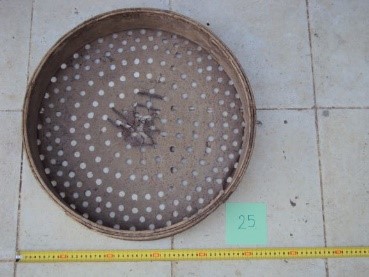 |
| Timitiri or Xistiri* Image from PIOP archive | Agricultural tool with metal head and wooden handle used to collect the mastic gum | 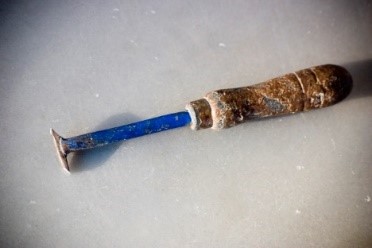 |
| Tsatali or Dikeli* Image from PIOP archive | Agricultural tool with metal head and wooden handle | 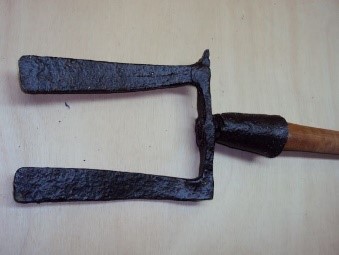 |
Digitisation of Mastic Cultivation Tools
The modeling of mastic cultivation tools was implemented from scratch in 3D using the Blender 3D
Access all tools from the following link.
Video documentation
Craft motion
Access all machines from the following link.
Documentation in 3D
Virtual environment
VR training
Section 2 – The Mastic Chicle industrial production
The Chios Gum Mastic Growers Association warehouse and factory
The Chios Gum Mastic Growers Association is an agricultural cooperation established in 1937 in Chora of the island of Chios, after a long period of crisis that the mastic market faced. While its establishment helped mastic growers have better work conditions in relation to their compensation, its first years of function were deeply affected by the Second World War and the German Occupation of Greece. Before the German Occupation, the Association traded mastic tears of various sizes and qualities. During the German Occupation, the Association was the appointed responsible by the German Financial Office for the supply of food for the local population. For this reason, they were granted special trade permits for mastic to effectuate food exchanges, mainly with Turkey. Nevertheless, these exchanges were not regular and therefore the reserves of the Association were filled with untraded mastic tears. After the Occupation and in order to boost the market, the Association decided to invest in the production and trade of mastic products, along with the tears.
Mastic was processed in the premises of the Association where mastic oil, rosin, resin wax, varnish and incense were produced. In 1952 was the first attempt to produce mastic chewing gum but it failed because of the recipe. After further research on the recipe and the establishment of a chewing gum confection unit at the premises of the Association, the first successful mastic chewing gum, ELMA, was created in 1957. This chewing gum became a trademark product of the Association and market demands started to raise significantly. The Association decided to expand its building in order to host more processes, such as chemical control of the products, manufacturing crates, and printing of packaging material. As sales increased, in 1988, a new chewing gum factory was established at the Kardamada region near Chora, which still operates today.
Production line at the warehouse and factory
After receipt of the mastic at the warehouse of the Association, the workers weight the product. Before storing the mastic tears, they are sifted in order to be separated in sizes and qualities, and then are washed in salty water. Salty water helps to further separate the mastic tears according to its cleanness. The mastic tears with the least impurities will float. Those are transferred for further cleaning by hand. The tears that sink to the bottom of the barrel with the salty water because as the mastic resin was drying in the fields, it absorbed dirt that cannot be cleaned by hand.
Workers clean the mastic tears by hand with the help of a pointy tool, usually a small knife. The clean but not very good looking tears are stored for the production of mastic chewing gum, and the tears that cannot be cleaned are stored for the production of mastic oil and incense. The clean, good looking tears are further washed with soap. After washing, the tears are spread on big sheets on the floor of a room with a fan to dry. When they are ready, they are weighted once again and are packaged.
For the production of the mastic chewing gum at the factory, workers create the chicle mixture by adding natural mastic, sugar (optional), butter and corn flour in a blending machine. The quantities of the ingredients are defined by the supervisor of the unit. The ingredients are blended with hot water for fifteen minutes in the heated cauldron of the machine. When the chicle dough is ready, the workers transfer it on a marble counter on top of which they have sprinkled icing sugar. Then they knead the chicle dough and form ‘pies’. The ‘pies’ are then placed on wooden shelves to cool down and later are transferred at the automated machine for their shaping into sheets and cutting into gum dragées. The dragées are cooled again on wooden shelves. When they are ready, workers break the sheets in order to separate the formed dragées. If the dragées are not well shaped, they are sent back for heating in the blending machine. If they are well shaped, they are loaded in the candy machine for coating. After coating has finished, the dragées are left to cool down and then are polished. When they ready, they are packaged and packed in boxes.
Digitisation of Mastic Factory Machines
Examples of machines that are part of the mastic chicle production industrial line are presented below:
Access all tools from the following link.
Creating stories of the avatar workers for the virtual warehouse and factory of the Chios Gum Mastic Growers Association
The virtual warehouse and factory of the Chios Gum Mastic Growers Association is based on the according exhibition space of the Chios Mastic Museum at the island of Chios in Greece. The space is designed to showcase the machinery that the Association first used during the 1950s and 1960s. The machines for the exhibition were a donation of the Association to the Piraeus Bank Group Cultural Foundation (PIOP) in order to include a section in the Chios Mastic Museum regarding the industrial processing of mastic. Thus, this museum space aims to offer to the visitor an experience of the industrial aspect of mastic during the 1960s through the exhibition and interaction with some of the machines.
In the framework of Mingei, after completing a series of co-creation meetings among the project partners, it was decided to enhance the experience of the visitors in this space by adding virtually the human element along with the machines. The goal of using human avatars is two-fold; on the one hand, they can offer information on the people behind the machines and the way of work and life in Chios at that time, and on the other hand, they can fill in a gap in the museum area, where it has been observed that the visitors do not follow or understand the order of processing mastic in order to produce mastic chewing gum.
To create human avatar workers for the exhibition space, as well as for the online version of the application, it was necessary to go through the archive of PIOP, and more specifically, the archive of oral testimonies of former and present-day workers of the Association (research of late 2000s) which is part of it. This helped to find information regarding the gender of the workers in each process, their age and family background, as well as information concerning the Chian society.
One of the most significant observations was that the majority of workers at the warehouse and factory of the Association were women. The age of the interviewees spanned from forty to eighty years old in a number of twenty-three participants. Although the participants did not work at the Association at the same time, it is interesting to notice differences and similarities, as well as developments in their lives, either as working women and/or in their personal lives.
Having those in mind, eight human avatars were created; seven females and one male. The idea of presenting gender neutral avatars was rejected because it would not reflect the time represented (i.e. the 1960s in the island of Chios, Greece). The profiles and stories of the avatars are a mix-and-match of the material in the oral testimonies. Each avatar comes from a different village of southern Chios (also known as mastic villages) or from Sidirounta (a northern village). The represented villages were chosen after their repetition of appearance in the archive, either in singularity, or by wider locality (e.g. the village of Kini might have been referenced once, so the profile of the participant will correspond better with those of participants coming from villages of the same area, as for example from Kalamoti). The age of the avatars was also defined as the middle age of the participants coming from villages of the same area.
In creating the content of the profiles and the stories of the human avatar workers, it was sought to represent how life at the villages was, how the worker grew up in the village (i.e. education, agricultural life, leisure time, adolescence, and married life), what led them to seek work at the Association in Chora of Chios, how their working life in the Association was, and in which process(es) they worked in. All this information is divided in sections according to (a) family background and early and adult years of life, (b) work life in the Association, and (c) process (es) explanation.
